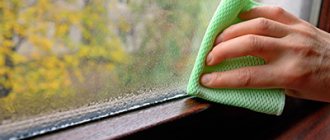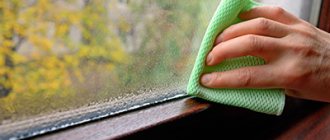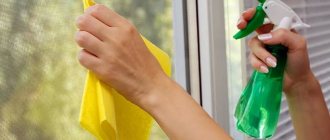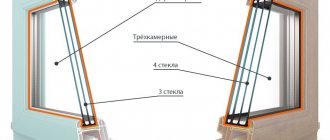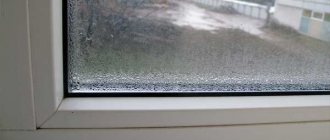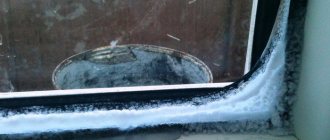Foggy windows are a problem for many cars. It’s not pleasant to look into foggy glass, regardless of its location - front, rear or side. A car window defogger helps solve the problem. You can buy it at an auto chemical store or make it yourself from available materials.
Window fogging is a problem in many older cars. But even new cars may have drops of condensation on the windshield or rear window during rain or snowfall. A car window defogger will help solve the problem. How do anti-fog products work? And how to make such a product on the go, from improvised means?
Why do car windows sweat?
Sweating of the windows inside the car often occurs during rain. It reduces visibility and poses a traffic hazard. Foggy windows block up to 35% of the light flux and thereby reduce the quality of visibility and the driver’s adequate assessment of the road situation. The cause of sweating is condensation. It collects (scientifically, condenses) on the windshield from the inside. It can also be collected on any other glass - side or rear.
Condensation is small droplets of water that settle on the glass surface. Certain conditions are necessary for them to fall out. This is the so-called “dew point”, a combination of a certain humidity and temperature. For example, with an air humidity of 62%, condensation will form at a temperature of +12 °C. But at a humidity of 95%, condensation will appear already at +20 °C. Thus, condensation is guaranteed if there is high humidity in the cabin.
The process of condensation formation can be controlled by temperature and humidity. In this case, the temperature is important not in the cabin, but on the inner surface of the glass. And also air humidity. What do these factors depend on, and how can their values be influenced?
Glass temperature
Determined by the outside air temperature. In winter and autumn it is quite low, so the glass is heated to prevent condensation. Cold glass will almost always be the site of condensation. The glass is heated with warm or hot air from the ventilation slots - this is the same with windshields. Or by transferring heat from heated wires - this is how rear windows are heated.
Condensation does not form on heated glass. If it has already formed, then when the glass is heated, the water droplets dry out within a few minutes. Therefore, in humid weather, the blowing and heating of the windows is turned on immediately, even before leaving the garage, in order to prevent them from fogging up.
Air humidity
The humidity of the air inside the car is the second factor that determines the fogging of the windows. When landing in the cabin, the humidity corresponds to the outdoor space. Afterwards, it may decrease if the hood works well enough.
When you get into your car during a rainstorm, you bring with you 90 percent humidity and condensation on the windows. Therefore, during rain, without waiting for moisture to appear, it is necessary to turn on enhanced exhaust ventilation of the cabin. The amount of moisture in the cabin air will be constantly replenished if 4 - 5 people travel in the car. In 1 minute, a person exhales 1 gram of water, which also remains in the cabin and can condense on the inner surface of the glass. An exhaust fan should also be running to remove moisture from passengers' breath.
A very useful and relevant article from our specialist talks about how a rain sensor works.
You can find out detailed information about whether it is possible to turn on the air conditioner in winter from the article by our author.
We also recommend that you study interesting material from an expert who is devoted to such a pressing issue as anti-rain for car glass.
To remove condensation, it is necessary that the air circulation is turned on “from the machine”. And one more thing: for high-quality ventilation, the cabin filter and evaporator must be clean.
You can also turn on the air conditioner - it will remove moisture and condensation in a few minutes. If the car is just leaving the garage, it will take time to warm up the engine. And only after this it will be possible to heat the glass with hot air. An exception to this rule would be the option of a separately operating stove. In this case, glass heating can be turned on from the start.
Reason for window fogging
A similar situation often occurs when it rains. As a result, visibility is significantly reduced, which creates a danger while the vehicle is moving. Foggy car windows let in 35% less light, which prevents the driver from correctly assessing the situation on the road. The main reason why such phenomena occur is considered to be the formation of condensation. This occurs due to high humidity, when the temperature of the glass is lower than inside the car.
Condensation itself consists of small drops of water settling on the surface. However, for them to appear, a number of conditions must be met. First of all, these are considered to be the presence of a suitable level of humidity, as well as the air temperature inside the machine. For example, when the humidity is 63%, condensation begins to appear at temperatures of 12 degrees. But at 94%, drops begin to settle on the surface starting at a temperature of 20 degrees.
Often indoor levels are approximately 55%, however, health doctors recommend keeping the humidity level between 60-70%.
Special products will help cope with the problem of glass fogging
In order to regulate the level of condensation on the glass and prevent it from fogging, it is important to control several factors:
- Glass temperature.
- Air humidity inside the car.
It is worth examining both factors in more detail.
Glass temperature
It is important to understand that these indicators are determined by external factors. So, in winter, the temperature of the glass will always be low, which is why it needs to be warmed up. On cold glass, moisture from the warmer air inside the car begins to condense. This process occurs due to a change in the state of aggregation of the liquid. To get rid of it, you have to turn on the car heater. Warm air causes moisture to evaporate from them.
When the glass is heated, condensation does not form on it due to the absence of a temperature difference.
Air humidity
This is another factor that is necessary for glass to fog. In late autumn, when it is raining outside, the humidity level in the car will immediately be high and reach up to 90%. When a person first gets into a car, the level of humidity in it matches that outside. After a certain time, its level rises along with the temperature. As a result, small drops of water begin to settle on the glass surfaces. This is especially true when 3-4 people sit in the car at once, each of whom exhales up to 1 g of water per minute and also heats the air. As a result, all this settles on the glass, which does not have time to warm up.
Moisture in the cabin: what to do?
If there is chronic humidity inside the car, it is worth checking the condition of the underbody and raising the rugs. If it is humid under them, the tendency to fog will be increased. What should I do?
- Dry the upholstery under the rugs.
- Place a porous absorbent substance under the driver or passenger seats. Cat litter is often used. Salt also works. It absorbs not only moisture, but also unpleasant odors.
- Check the condition of the seals and, if necessary, change them so that rainwater does not enter the car interior.
- Check the serviceability of the engine cooling system - it can also be a source of moisture for the interior space.
Be sure to read the article about which car lock defroster to buy or how to make it yourself.
Find out what benefits a heated windshield gives a driver and how to install this function correctly in our article.
Means for treating foggy glass
To solve the problem of fogging, the automotive industry produces various glass treatment products. They are called anti-fog and anti-rain. They come in the form of aerosols or liquids and are sold in auto chemical stores at an average, affordable price.
Almost any car window defogger is alcohol-based. This is a fairly reliable product that reduces the amount of condensation on the glass and improves visibility during rain. However, there are situations when there is no ready-made anti-fog agent, but you need to go. It’s raining outside, 5 people are sitting in a car, and condensation is constantly forming on the windows. What home remedies can replace auto chemicals?
WD – handy auto chemicals
If an anti-fog agent is a special substance that needs to be bought at a car store, then WD is a rust remover liquid, which is often stored in a car enthusiast’s garage and is used for various purposes. You can also treat glass with WD solvent to prevent it from sweating.
Auto chemicals: how to use correctly
Store-bought anti-foggers are auto chemical items. Almost all of them are made on the basis of technical alcohol, to which chemical components are added - flavorings, thickeners, preservatives. For the auto chemicals to work effectively, the following rules must be observed.
- The anti-fog agent should be sprayed or applied to clean, washed and dried glass. Definitely dry.
- Can be applied in two or more layers, several times. This will increase the operating time of the product.
- Renew the substance in a timely manner, apply the solution or aerosol anew every 2 weeks.
What else should I treat with anti-fog?
Anti-sweating glass products will be very useful on other surfaces of the car. What else should be treated with an autochemical solution?
- Surface of exterior mirrors. Anti-fog treatment will be similar to anti-rain treatment. During rain or fog, drops will not accumulate on the mirror.
- The outer surface of the glass. This is true for rainy climates or during the season of frequent rainfall. And also for side windows that are not equipped with wipers. During heavy rain, water droplets will quickly roll off the frontal surface. The glass will be clean and visibility will be high.
How to wash windows to stop them from sweating?
If the cause of condensation has been identified, you can proceed to the next step - removing moisture from the glass surface. To remove moisture and prevent its occurrence, the following products may be needed:
- Water container - bucket, basin, etc.
- Woolen rag.
- A rag made of soft, lint-free fabric.
- Old and unnecessary newspapers.
- Microfiber.
- Glycerol.
- Soap solution.
- Shaving foam (not to be confused with gel).
- Vodka (it’s better to take alcohol).
- Scraper with a rubberized nozzle at the end.
- Special means – anti-fogging agents.
Reasons why car windows sweat
When the windows become covered with moisture, the driver is forced to take time away from driving the vehicle and periodically wipe the glass with napkins or rags.
Car windows sweat from the inside for the following reasons:
- The difference in the temperature of the environment and the interior space of the cabin. Similar phenomena occur in the cold season or early in the morning, when the air has not yet warmed up. Moisture from the air settles on surfaces in the form of condensation.
- Precipitation. During snowfall and rain, the humidity level inside the car increases. Dampness penetrates into the cabin through open doors, windows, and on the clothes and shoes of the driver and passengers. The fumes come from umbrellas and wet rugs.
- Radiator malfunction. When coolant leaks, a large amount of steam is generated. At the same time, the windshield fogs up, on which oily inclusions appear. It is necessary to stop and check the condition of the cooling system.
- The filter, which is part of the interior air conditioning equipment, is dirty. It may be clogged with dust or oil fumes.
- Consequences of washing a car at a car service center. The interior may not have been properly dried after cleaning.
- Incorrectly configured climate control system or its breakdown. In such cases, the space in the cabin ceases to be dried, and damp air is pumped in.
- Passengers who have consumed large amounts of alcoholic beverages. During breathing, alcohol vapors are released and settle on the windows. Alcohol absorbs water molecules, resulting in condensation.
Folk remedies
In turn, comprehensive actions tend to cost more, but in exchange they help get rid of the problem forever. If plastic windows sweat heavily inside, the fight against steam condensation should begin with determining the causes of this phenomenon.
What can I do to prevent windows from sweating and are there any effective ways to prevent this? Let's look at everything in order, and you choose what suits you best.
If windows sweat, the most common reason for this phenomenon is increased humidity in the room. To prevent windows from becoming covered in steam, you must first take care of ventilation. Currently available structures are characterized by a high degree of tightness.
This is not a disadvantage, because sealed double-glazed windows can significantly save on heating your home or apartment. We often think that steam that appears on glass is the result of structural defects or errors during installation and assembly.
In fact, the phenomenon of condensation on windows appears even in the case of fairly well-functioning and correctly installed double-glazed windows. Another question is why windows inside double-glazed windows sweat; there is a high probability of installation defects.
Perhaps we forget to turn on the hood while cooking, or we dry too much laundry at once and avoid airing. In contrast, exterior glass vapor coating is typically dictated by weather conditions and the location of the building.
This phenomenon is observed especially often when the house is located close to water, or when there is a lot of vegetation right outside the window that collects moisture from the air.
Situations that may give rise to a claim against a window manufacturer or installer primarily include:
- the plastic window inside the glazing is sweating (the master can answer why the plastic window is sweating inside; it is probably a structural defect if it sweats between the windows);
- local presence of wet spots (probable assembly defect).
It should be noted that the presence of a sealed double-glazed window inherently requires the proper functioning of the building's ventilation system, namely the need to remove excess moisture from the rooms and bring in fresh air from outside. The correct climate in residential areas requires that the rooms should be provided with 30 to 50 cubic meters of fresh air per hour. And in kitchens and bathrooms, that is, rooms with high humidity levels - 70 m³.
When the temperature outside the window drops, and in the rooms we raise the temperature with heating, the glass can react by so-called fogging, or the formation of steam drops on them. The phenomenon may occur more often when there is strong dampness outside, windows often sweat in the rain and as a result of our normal household procedures, for example, cooking, drying clothes in the apartment, taking a bath, etc. In some cases, traditional ventilation power may not be enough.
We suggest you familiarize yourself with: Liquid glass for ceilings
Frequently opening the window and ventilating the rooms eliminates the problem if double-glazed windows sweat. This is not an expensive procedure, accessible to everyone. The problem, however, is that in autumn or winter the weather does not allow the apartment to be ventilated often.
Frequent ventilation, especially in cold weather, can cause large heat losses and therefore contribute to higher energy bills for heating.
What can I do to prevent plastic windows from sweating when there is high humidity? Of course, ventilation is necessary, but requires compliance with specific rules.
As mentioned above, the tightness of modern window products cannot be interpreted as their disadvantage. But when conventional ventilation in a building fails to prevent PVC windows from sweating, the efficiency of the ventilation system can be improved by equipping double-glazed windows with a ventilation function, or by installing diffusers. Ventilation is carried out by installing the handle in a certain position.
Microventilation is an excellent way to prevent windows from sweating. The advantage of diffusers is that you can decide to use them at any time during the installation of a double-glazed window. These devices allow ventilation without the need to open the doors wide open.
Thanks to the location of the ventilation holes in the upper part of the double-glazed window, the incoming cold air is mixed with the heated air inside the room under the ceiling.
Before it drops to the level we perceive, it will reach room temperature, which is acceptable and comfortable for humans.
The solutions proposed above are effective and most rational, and work great. Nevertheless, many residents of houses and apartments try to use folk remedies if the windows in the house sweat. What are these means?
Home and folk remedies to prevent the windows in your house from sweating:
- Installing fans in the ventilation openings in the apartment (these devices, however, must be running constantly, or at least most of the day, which unfortunately creates costs associated with electricity consumption).
- Installing dehumidifiers on or near window sills (buying a small dehumidifier will not incur significant financial costs, but it is not clear whether they will be powerful enough to reduce indoor humidity).
- Turning on the hood while cooking (a normal hood can remove a significant amount of steam produced during cooking).
- I often wonder what to use to clean windows to prevent sweating? It is possible to use special preparations that are designed to eliminate the formation of condensation on glass (but if the windows in the house sweat a lot, such products, as a rule, do not work).
- Limiting household activities that increase the level of air humidity in the room (short baths and immediate ventilation of the bathroom after this operation, drying clothes on the balcony and outside in well-ventilated places, etc.).
- Some folk methods involve wiping glass with special solutions. This can be: - a salt solution (a tablespoon per three-liter bottle); - a mixture of glycerin and alcohol in a ratio of 1:10.
But you don’t have to spend money on car cosmetics; you can get by with improvised means. A proven way to dilute glycerin in alcohol in a ratio of 1/10 and wipe the glass with this composition. It is also recommended to use aftershave cream; it also prevents moisture from collecting on the windows. Alternatively, you can wipe the glass with newspapers; printing ink contains substances that will prevent water from condensing on the glass.
Text: Natalya Khalezova
Photos from Internet resources
Tags: sweat, lubricate, glass, to
« Previous entry
How to remove fogged windows in a car?
There are various methods to combat fogging of car windows.
There are general rules for eliminating condensation:
- Adjusting the air conditioning system. It is necessary to ensure that the windows are constantly blown with warm air.
- Installation of several high-quality moisture absorbers in the cabin. Sorbents effectively absorb water from the space, drying it to the required condition.
- Treatment of glass with special agents that have hydrophobic properties. Even water molecules do not linger on them. Such products are produced in the form of aerosols, liquids and impregnated wipes.
- Opening windows a few millimeters. The resulting air circulation ensures the evaporation of condensation from all surfaces.
- Ventilation (air ventilation) and preventive drying of the interior. This helps to dry the upholstery of chairs, rugs and remove liquid accumulated in the niches.
- Regular vehicle maintenance. Timely replacement of filters, sensors and valves will prevent excess moisture.
In the rain
When it rains, water penetrates into the interior of the car, which, when heated, turns into steam, settling on windows, metal and plastic in the form of tiny drops.
You can get rid of glass fogging in inclement weather in the following ways:
- After starting to drive, open the windows on both sides of the car. The resulting turbulence will ensure condensation is blown off the panels.
- After finishing the trip, park the car in a heated garage. If possible, leave windows and doors open to dry out the cabin.
- Before planting, shake off snow and water from clothes and shoes, pack wet umbrellas in plastic bags or covers.
- Before the onset of the wet season, warm up the interior with a hairdryer to remove moisture from the upholstery. When damp air penetrates, the fabric plays the role of a sorbent.
During the winter season
During the cold season, the formation of condensation complicates the already difficult road situation. In addition, there is a risk of sweat freezing and ice crusts forming on the windows.
What you can do:
- Set the maximum heating temperature by directing the air flow to the front panel. Heat in the cab can be eliminated by opening the side windows.
- Use special preparations against condensation formation. Modern anti-fogging solutions for car windows allow you to get rid of this phenomenon without excessive heating of the interior.
- Install electrically heated panels. This will require additional costs, but they are offset by the comfort and safety of travel.
Useful tips: how to treat glass to prevent sweating
Today there are ways to protect car windows from fogging. There are two methods:
- stick a protective film (anti-fog);
- use folk or chemical remedies to protect against moisture (car window defoggers).
Anti-fog films for car windows
A new product in the field of protecting glass from moisture is a specially designed anti-fog film. The same film is applied to motorcycle helmets. Using this method, you do not have to use chemicals often. This film performs its functions perfectly and is also durable.
The use of anti-fog films, in addition to protecting against moisture, also strengthens the glass and also protects against infrared and ultraviolet rays.
Chemicals to defog car windows
The auto chemical industry does not stagnate; new auto glass anti-foggers are constantly appearing to protect against moisture formation. The disadvantage of using a chemical anti-fog agent is that the special liquid can be “thermonuclear” with a terrible odor, as in the case of non-freezing liquids with an odor.
How to use the defogger
- The first thing you need to do is wash and dry the car glass well.
- Then you need to shake the chemical liquid.
- Application of the chemical solution, depending on the packaging design, is carried out by spraying or with a napkin or cloth.
- Now you have to wait 30 minutes. Do not touch with hands, do not wipe.
- When the anti-sweat dries, the glass should also not be touched with your hands.
If it happens that you applied the defogger correctly, but the windows in the car still sweat, then this is for two reasons:
- or you have come across a fake liquid;
- or the applied layer was washed off or wiped off by hand.
To protect yourself from purchasing a counterfeit, it is advisable to buy the product in specialized large stores. On the highway, as in the case of antifreeze, antifreeze and antifreeze, there are a lot of fakes.
Let's look at the most popular anti-fog car windows in Russia and the CIS countries:
- SINTEC (Sintek). Russian anti-fog agent.
- VELV. Russian. Volume 210 ml. Cost up to 150 rubles.
- ELTRANS (Eltrans). Russian. Volume 210 ml. Price is about 110 rubles.
- ABRO (Abro). USA. Bottle volume 100 ml. The price is approximately 200 rubles.
- SONAX (Sonax). Germany. Bottle volume 300 ml. Costs 300 rubles.
- CARPLAN (Carplan). England. Volume - 250 ml. The price is within 250 rubles.
- No. 1. The best anti-fog agents for auto chemicals were the German Sonax and the English Karplan. The level of light transmission after their use decreased by 8%, that is, minimal humidity, which almost did not impair visibility.
- No. 2. The Russian Sintek and the American Abro came second in this rating test. They reduced visibility by 12%.
- No. 3. The third one is also of Russian production: Vals and Eltrans. They dimmed visibility by 21%.
Folk remedies for preventing fogging of car windows
Folk remedies are a great way to protect yourself from the formation of moisture on glass from the inside. According to reviews from drivers who used certain folk remedies.
So, what folk remedies are used to rub glass to prevent sweating:
- Lemon. Using lemon, namely rubbing the glass and wiping it dry with a clean rag, the inside of the glass will remain dry for a long time.
- Toothpaste. Perfect if it contains menthol. Rub and wipe dry with a cloth. There is no need to rinse with water. The headlights are protected in the same way.
- Shaving cream. Just as in the case of toothpaste, if the composition contains a refreshing component, for example, menthol, then this product will perfectly protect against moisture.
- Coffee. They don't need to be rubbed. It must be placed in an open container and it will absorb moisture from the air.
- Newspaper. The principle of using newspaper is the same as with coffee. Just put it on the front of the dashboard and on the back on the shelf in front of the window. It will absorb moisture from the air. The easy way.
- Diaper. Used as a moisture absorber. Simply open it and place it next to the window.
- Potato. Rubbing potatoes will create a protective starch film for some time.
- Salt. Also, the moisture-absorbing element cannot be rubbed with it.
Anti-fog films
A good result in the fight against condensation is obtained by covering windows with a special film. The basis of the material is polycarbonate - a polymer with high strength, abrasion resistance and hydrophobic properties. The reverse side has microscopic notches and is smeared with transparent glue. The outer layer repels water molecules, which roll down until a visible layer of perspiration forms.
The gluing process is not particularly difficult. You need to do the following:
- cut a workpiece slightly larger in size than the panel being processed;
- thoroughly wash and degrease the glass, wipe it dry;
- Remove the protective coating from the film, apply it to the panel, and remove air bubbles with a spatula.
Anti-fogging with a special film
There is another very effective way to combat the formation of condensation on the surface of glass - this is the use of a special film. It is made of durable, abrasion-resistant polymer material – polycarbonate.
One side of the film has an adhesive base for fixing to glass. The outer layer, due to its hydrophobic properties, repels water. As a result, it rolls off before the glass fogs up.
The film is applied quite simply, but requires special care. The first step is to cut out a piece of material in the shape of a window, but a little larger. The glass surface is cleaned of dust, degreased and dried. Afterwards, the protective layer is removed from the adhesive base and it is pressed tightly against the window. All air bubbles are removed with a special spatula.
Prevention of glass fogging
To avoid condensation, you should follow a few simple rules:
- Before boarding the cabin in conditions of heavy rainfall, place pieces of cellophane, old linoleum or unnecessary rags on top of the mats. They will collect water from the shoes, which can then be easily removed from the interior.
- Before a long trip, pre-rub the glass with mastic, glycerin or another long-acting product. Always have a supply of anti-icing and de-icing agents on your windows.
- Periodically dry upholstery and rugs. Dry things can act as a sorbent for a long time.
These methods will reduce the humidity in the cabin and reduce the likelihood of windows fogging in any weather conditions.
In the autumn-spring, and even in the winter, car windows very often sweat (even in new and working cars). There are many reasons for this, and a stove or air conditioner does not always help. Therefore, now a lot of different “anti-foggers” have been “thrown” onto the car cosmetics market, which help fight this phenomenon. BUT not all of them cost adequately, and some simply do not work. Today I will tell you a recipe for such a composition with my own hands, and for mere pennies...
All the remedies below have been tested by me personally and really work. They can be used not only in a car, but also for swimming goggles or home windows. However, some work better, some worse.
Fighting fogging with traditional methods
If you don’t have a special product at hand and there are no auto shops nearby, it doesn’t matter. You can use one of the traditional methods. They effectively combat the formation of condensation on the windshield, and the necessary materials can be easily purchased at a regular grocery store or pharmacy.
The following will help combat glass fogging inside your car:
- Regular table salt. You need to dissolve it in a small amount of water and rub the mixture on the panels and interior windows. After spreading rag bags with salt around the cabin, they will absorb excess moisture from the air. However, you need to be careful with this method, as salt can cause metal corrosion.
- Lemon. The fruit is cut in half and its half is carefully rubbed onto the sweating surfaces of the cabin. This method has an additional pleasant bonus - flavoring.
- Laundry or toilet soap. Take a block and draw random stripes on the glass. Then you need to thoroughly rub everything with a damp cloth. This way we get a uniform glycerin film.
- Shaving cream. The procedure is similar to the previous one, only you need to do everything a little faster, since the cream dries quickly.
- A mixture of alcohol and glycerin. We take two substances in a ratio of 1:20 and mix well in a container. We treat the surfaces of the windows with the resulting composition using a cotton pad, rags or a spray bottle.
Before starting treatment using any of the methods, the surface must be cleaned of dirt and then dried thoroughly. To do this, you can use a sponge, clean rags, crumpled newspaper, or better yet, use microfiber.
Regular soap
If anyone doesn't believe it, try applying it to the windows. This is an old, ancient method that has been working for years (by the way, soldiers used it to treat the glass in gas masks so that they would not sweat).
The principle of application is simple. You need to apply the “mesh” with a bar of soap to the car windows and then rub it well. The composition works reliably, the efficiency is HIGH.
There are also disadvantages - you can only do this in warm weather, because it is VERY difficult to grind such a mesh in the cold
Tools and accessories
In order for the process of eliminating the problem with double-glazed windows to be carried out in a short time, it is recommended to prepare all the tools and devices in advance, namely :
- rags;
- rubber scraper;
- container with water;
- brush with bristles;
- sheets of paper.
This is a standard set for washing glass, but it is also useful for solving the problem of condensation.
It is better to take two types of rags: fleece-based and woolen .
Fleece or viscose rags are very good at cleaning the glass surface from dirt.
A woolen rag is suitable if you need to apply a certain composition to the surface of the glass and rub it in.
also use a microfiber type cloth that does not leave streaks on the window.
A rubber scraper is necessary if there are old stains on the surface of the window that have become embedded in the glass. Most likely, you won’t be able to remove them with a regular rag, so you’ll have to wet the surface and use a scraper. For the same purposes, you also need a brush that will help remove dust that has settled on the windows.
You should choose a container with water that is convenient for washing the window. If the surface is large, it is better to take a bucket and periodically change the water in it. Sheets of paper are also needed if rags still leave marks on the glass.
Shaving foam or gel
Personally, I myself use this method and I think that this is the best do-it-yourself anti-fog for the money. And the most important thing is that both are available in almost every home and there is no need to spend extra money on purpose.
Application method - you will need paper towels (gel works better, not much, but still). Squeeze out a little and rub the glass. Next, take a dry towel and treat the surface until transparent.
The efficiency is the highest. Almost no cons
Now watch the video version
In conclusion, I would like to say that these anti-fog recipes will of course help you, but if it’s damp on your rugs and especially under them, you can squeeze it out, then you need to first dry the interior and then treat it, otherwise the effect will be much worse.
You can also advise putting some cat litter in a small bag, say under the seat, it will absorb excess moisture and keep it inside. You need to change it about once a week or two (it will simply swell).
This is where I end, I think my article and video were useful to you. Subscribe to the channel, read AUTOBLOG.
( 9 votes, average: 5.00 out of 5)
Similar news
Evaporation of antifreeze and other causes of its leakage. Let's take the fur off.
The antifreeze (TOSOL) has darkened and turned brown. Why? Let's analyze the wasps.
Do-it-yourself anti-freeze. How to make for a car, methods with spir.
“>
